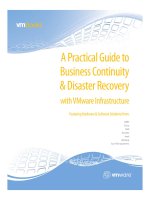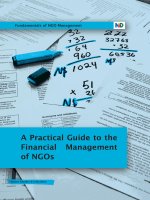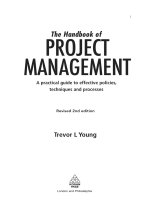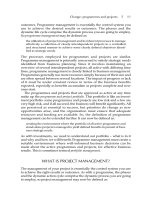The Handbook of Project Management: A Practical Guide to Effective Policies and Procedures, 2nd Revised Edition_1 doc
Bạn đang xem bản rút gọn của tài liệu. Xem và tải ngay bản đầy đủ của tài liệu tại đây (305.84 KB, 24 trang )
i
Trevor L Young
The Handbook of
PR OJECT
MANAGEMENT
A practical guide to effective policies,
techniques and processes
London and Philadelphia
Revised 2nd edition
ii
First published 1996
First paperback edition 1998
Second edition published in Great Britain and the United States in 2003 by Kogan
Page Limited
Reprinted 2004, 2005 (twice), 2006
Revised second edition 2007
Apart from any fair dealing for the purposes of research or private study, or criti-
cism or review, as permitted under the Copyright, Designs and Patents Act 1988,
this publication may only be reproduced, stored or transmitted, in any form or by
any means, with the prior permission in writing of the publishers, or in the case of
reprographic reproduction in accordance with the terms and licences issued by the
CLA. Enquiries concerning reproduction outside these terms should be sent to the
publishers at the undermentioned addresses:
120 Pentonville Road 525 South 4th Street, #241
London N1 9JN Philadelphia PA 19147
United Kingdom USA
www.kogan-page.co.uk
© Trevor L Young, 1996, 2003, 2007
The right of Trevor L Young to be identified as the author of this work has been
asserted by him in accordance with the Copyright, Designs and Patents Act 1988.
ISBN-10 0 7494 4984 5
ISBN-13 978 0 7494 4984 1
British Library Cataloguing in Publication Data
A CIP record for this book is available from the British Library.
Library of Congress Cataloging-in-Publication Data
Young, Trevor L. (Trevor Leonard), 1940-
The handbook of project management : a practical guide to effective
policies, techniques and processes / Trevor L Young. Rev. 2nd ed.
p. cm.
Includes index.
ISBN-13: 978-0-7494-4984-1
ISBN-10: 0-7494-4984-5
1. Project management Handbooks, manuals, etc. I. Title.
HD69.P75Y68 2007
658.4Ј04 dc22
2007017489
Typeset by Saxon Graphics Ltd, Derby
Printed and bound in Great Britain by Creative Print and Design (Wales), Ebbw Vale
Contents
Preface to the revised second edition vii
Part 1 The programme and project environment 1
1 Introduction 3
What is special about programmes and projects? 4
Who is this book for? 5
2 Change: programmes and projects 7
Change and the programme and project manager 8
What is a project? 9
Projects and sub-projects 10
What is a programme? 12
An example programme 14
Why programme management? 14
What is programme management? 16
What is project management? 17
Why is programme management different from project
management? 18
What is different about programme and project management? 19
How are programmes and projects derived? 21
The dynamic life cycle 23
The dynamic action cycle 24
The programme and project process phase gates 26
Is the phase gate a constraint? 28
Is this control necessary? 29
Summary 30
iii
3 Organizing for programme management 31
Organizing for ownership 33
Establishing the programme steering team 34
Continuous improvement and problem solving: are they projects? 36
The programme register 37
Operating a programme register 37
The key responsibilities of the programme steering team 41
Meetings of the programme steering team 42
Managing the portfolio: selection of programmes and projects 44
The inputs to effective selection 46
The secondary screening 48
The result of effective selection 49
Summary 51
4 The key roles 53
The project steering team administrator 54
The sponsor 55
The programme manager 55
The project manager 56
The functional manager 56
The stakeholders 57
Frequently used terms 59
The programme and project manager as a leader 60
The dimensions of leadership in the programme and
project environment 62
Dimension 1: Managing stakeholders 63
Dimension 2: Managing the dynamic life cycle 66
Dimension 3: Managing performance 66
Programmes, projects and teamwork 67
Building your team 70
Customer satisfaction 71
Summary 72
Part 2 The programme and project processes and techniques 75
5 Starting up: ideas and opportunities for projects 77
The fundamental data needs 78
What are the constraints? 79
What data does the programme steering team require? 80
Preparing the initial business case 80
Through Gate Zero to Gate One 81
Presenting the business case to the programme steering team 87
The kick-off meeting 88
Project documentation 91
The project brief and specification 95
Summary 97
iv
l
Contents
6 Defining the project 99
What is necessary to define a project? 99
The stakeholder list 100
The project brief 101
The scope of work statement 105
Risk management 107
Risk assessment 110
Quantifying identified risks 114
Risk monitoring 120
Getting your project definition approved 120
Summary 123
7 Planning your project 126
What is not going to be done? 126
Who needs to be involved? 127
Where does planning start? 127
Identifying the key stages 128
The project work breakdown structure 131
Allocating responsibility 132
What is an estimate? 134
Avoid some classic pitfalls 135
The golden rules 137
Effort and duration 137
Estimating the durations 139
Contingencies 142
Time-limited scheduling and estimates 143
Identifying the critical path of your project 145
The programme evaluation and review technique 146
Analysing the logic diagram 149
Using the PERT analysis data 149
Analysing your resource requirements 154
Optimizing your schedule 155
Reviewing your project risk log 159
Reviewing your project budget 160
Intermediate phase gates 161
Seeking approval to launch your project 162
Summary 164
8 Launching your project 166
Establishing key stage work plans 166
Deriving a milestone schedule 169
Critical success factors 171
Ensuring effective communication 173
Project status reports 174
Deriving a meetings schedule for your project 177
Managing project changes 178
Contents
l
v
Holding a launch meeting 185
Summary 188
9 Executing the project work 190
The project control system 191
Monitoring progress 195
Managing issues 198
Reviewing project issues 206
Tracking your project 207
Taking corrective action 212
Problem solving 214
Progress meetings 217
Progress reporting 220
Encouraging good time management 222
Controlling the project costs 228
Balancing the project 234
Approaching the closure phase 238
Summary 239
10 Closing your project 242
Why have a closure phase? 243
Establishing completion criteria 244
The acceptance process 246
The close-out meeting 247
Evaluating your project 251
Closing down the project 252
Post-project evaluation 254
Post-project appraisals 258
What next? 259
Summary 261
11 Using a computer 263
What can software do? 264
Using a software program 267
What software does not do 270
Selecting project software 271
The programme management office 271
12 Common project problems 274
Problem analysis 274
How projects succeed 280
Postscript 282
Appendix 1: Glossary of terms 283
Appendix 2: Further reading 289
Index 291
vi
l
Contents
Preface to the revised second
edition
Welcome to this revised second edition. Several significant changes were
made in the second edition. In this revision most chapters have had some
modifications and additions. In particular, in Chapter 7 there are addi-
tional techniques on estimating and in Chapter 9 the techniques of project
balancing have been revised. A new Chapter 12 on the common problems
of project management has been added. The main structure of the work,
divided into two parts, remains unchanged.
Part 1 looks at the programme and project environment. This includes
how programmes have evolved and relate to projects and introduces the
process for managing an idea or opportunity as it progresses from initial
selection on through the different phases of a programme or project. The
concept of phase gates to allow senior management control over the
programme and project activities is included. These techniques depend
very much on organizing for programme and project management, ensur-
ing that the strategically appropriate programmes and projects are
selected to create a portfolio of active projects and programmes. Finally in
Part 1, the roles and their responsibilities are discussed to enable effective
management of the portfolio.
Part 2 has been extensively revised to ensure that the processes and
techniques described fit the programme and project environment. The
detailed processes for managing an opportunity through each phase gate
to completion have been enhanced with new material. The risk manage-
ment process has been modified to include quantitative risk assessment.
The issue management process and the change management process have
been extensively revised on the basis of practical experience. Additional
vii
cost control and earned value analysis techniques have been added.
Finally, the project closure process has been enhanced.
This book is based on over 30 years’ experience in the project environ-
ment, and in that time I have learnt much from others – and much the
hard way of ‘try it and see if it works’. I could not begin to list all those who
have helped me on that journey, working together at different times to
achieve a successful project outcome. Programme management has not
been easily understood in many companies. I would like to acknowledge
the huge amount of commitment and support from Ken Foster and thank
him for the many hundreds of satisfying hours we have spent together
persuading others of the value of the techniques in this book. I thank Ken
also for his many suggestions and helpful comments on the material in
Part 1. Finally, I thank Christine, my wife, for tolerance, patience and the
support she gave to help me complete this project on time.
viii
l
Preface to the revised second edition
Part 1
The programme and project
environment
Part 1 is focused on understanding the steps that an organization needs to take
to create an effective environment for success in programme and project
management. This includes understanding the terminology and the organiza-
tional structure changes advisable to take advantage of a programme-oriented
environment in the business.
Part 1 also looks at the steps necessary to institute a formalized approach to
programme and project selection and at understanding the essential roles and
their responsibilities that are required for these processes to be effective.
1
2
This page is left intentionally blank
1
Introduction
During the past decade the skills of project management have become
increasingly recognized as highly desirable for managers at all levels in an
organization. Most people today can benefit from the application of these
skills to some parts of their daily operations. The rapid growth of global
markets and the introduction of Total Quality Management, continuous
improvements and, more recently, the drive to redesign business
processes all require these skills to some degree. All are aimed at improv-
ing organizational effectiveness and performance in a highly competitive
world marketplace. The world marketplace is continually changing and
every organization, irrespective of the service or product it offers, must
accept that internal change is a normal process to meet the demands of
external change.
The successful and effective implementation of change employs specific
skills that have traditionally been owned by a select group of technical
professionals. This is no longer true, and the skills of managing change are
essential for everyone in an organization at all levels. Change always
requires a cultural shift for everyone:
• introducing new processes;
• finding new and better procedures and working practices;
• throwing off the old habits to create a more dynamic and flexible
organization;
• being able to react effectively to market forces;
• searching for ways to maintain competitiveness;
• searching for ways to seek new horizons.
To carry out such change requires some special skills. Project management
has long provided a structured and organized way to achieve success
3
every time, but has been buried deep inside technical and engineering
departments as part of their exclusive domain. Unfortunately, it is not
surprising that project management has been regarded as too complicated
and as a result is frequently misunderstood and very poorly practised in
other parts of the business.
WHAT IS SPECIAL ABOUT PROGRAMMES
AND PROJECTS?
If you ask anyone what is special about projects, expect to get a confused
variation of responses. The Channel Tunnel, Concorde, North Sea oil rigs,
motorways, inner-city development, landing on the moon, the Taj Mahal,
the Pyramids and countless others are readily recognized as ‘projects’.
Certainly all can be termed ‘special’ – all have a clearly recognizable
specific result at the point of completion and we can see the result thanks
to the use of modern technology and communications. Each is unique and
unlikely to be repeated again in quite the same way with identical results.
These large undertakings involve a wide range of technical skills and,
often, large numbers of people. At the other end of the spectrum many
unique but much smaller undertakings occur in every type of organiza-
tion; they use fewer people but still require many skills to produce a
desired result. All these activities involve change since they are concerned
with creating something that does not yet exist. The sum of the activities
directed towards a specific result is regarded as a project.
In recent years the term programme has entered the project environment
and, not unexpectedly, caused considerable confusion. Originally it was
perceived as a management tool, just a convenient way of grouping some
projects together so that they all came under the responsibility of one
senior manager. This apparently reduced the burden of reporting effort
required but conveniently hid from view many of the issues and delays
occurring. Others saw a programme as an ongoing specialized activity
with no clear end-point, such as, for example, marketing campaigns and
space exploration. Fortunately, a more rigorous understanding of
programmes has now been accepted, with significant benefits.
Programme and project management is now more widely accepted as an
essential business discipline for all professions.
Such activities are frequently carried out outside the normal operations
that keep the mainstream activity of the organization moving to satisfy its
customers. Programme and project management is seen as a burden on
people, one demanding valuable time and resources. It incurs a commit-
ment of expenditure of today’s profits to generate future enhanced perfor-
mance and benefits.
4
l
The programme and project environment
WHO IS THIS BOOK FOR?
Anyone involved in programmes or projects, regardless of their status or
role in an organization, will benefit from reading this book. But that is not
its real purpose. The book is written with two specific aims:
• to give managers in the organization a better understanding of
programme and project management and how to establish an effec-
tive environment to achieve results;
• to give you, the programme or project manager, a guide to help you
improve performance using well tried and tested tools and techniques.
The skills of project management are not the only tools you will need to
become more effective, yet many of these tools are valuable in your every-
day work. It is clearly recognized that you do not spend all your time
managing programmes or projects and it is more likely to be an occasional
responsibility at some time in your career.
The book has been carefully designed to meet your needs if:
• you are looking to help your organization become better organized to
select and manage a programme and project portfolio;
• you are looking to develop the skills of effective programme and
project management to help you in your work as a member of a team;
• you are about to start work on a programme or project, having just
been appointed to the role of programme or project manager;
• you have managed programmes or projects already but are seeking to
improve your skills and welcome an opportunity to review your
present knowledge, add some new tools and techniques to your
personal skill set and improve your performance;
• you have an involvement in programmes and projects and need to
coach others in the application of the appropriate tools and techniques
in a proven process.
This is not an academic textbook offering you complex theories to learn.
The tools and techniques of effective and successful programme and
project management are practical and relatively simple to understand.
This does not mean they are always easy to apply, because of the complex-
ity of the work and the effects of scale. The emphasis is on business
programmes and projects, which are often small and of short duration
when compared to highly technical or construction projects.
The book is written as a pocket guide, so it is not a book to read once and
place in the bottom draw of your desk, never to see the light of day again!
It is a tool to be used frequently to help you, remind you and support what
Introduction
l
5
you do at each step along the road from start-up of an opportunity for a
programme or project through to successful completion. Throughout you
will find practical tips and checklists for each step to help you achieve the
results expected.
Enjoy and be successful.
6
l
The programme and project environment
2
Change: programmes and
projects
Change in today’s world affects everyone. You face a changing environ-
ment both in your private life and in the business world in which you
work. Some of these changes are beyond your control, such as the
weather, which not only changes with the passing seasons, but seems to be
changing in its behaviour with the passing years.
Not all change is so automatic and uncontrolled. You can choose to
create change in your life by taking carefully framed decisions. You
choose to change jobs, move house, or adopt a different lifestyle as an
expression of your personal desires and as a means of satisfying your
current needs.
However, frequently you face changes that you do not choose because
the decision is taken by another. You do not like an increase in taxation but
someone decides it is essential for the greater good of the economy. Such
change is obligatory for all, and you have to face consequential changes
and take decisions to further adapt your lifestyle to accommodate the
reduction in income. Similarly, others at work take decisions about how
you must work or what you do; you have no input to the change and you
are expected to accept the new environment that results. Technological
advances continue to affect you at an increasing pace, creating additional
stress through the need to keep up to date. One thing is a certainty: the
pace of change will continue to increase in the future.
The consequences of change range from trivial through to very signifi-
cant, affecting your response. Success in managing change is directly
related to your ability to:
7
• understand the current reality;
• carefully design the change process;
• manage the consequences.
Treat the change as an opportunity and a challenge. Selected change
usually creates positive behaviours and constructive responses, whereas
imposed change often generates open and latent opposition, negative and
critical responses and even open sabotage. These consequences must be
effectively managed for a successful outcome.
CHANGE AND THE PROGRAMME AND
PROJECT MANAGER
Programmes and projects are concerned with creating and managing
change in an organized and structured manner. Proven tools and tech-
niques are available to you but you must also focus on the impact on
people. A successful outcome is a direct measure of your ability as an effec-
tive change agent.
You are faced with dealing with the fears that act to restrain the change
process. At the same time, you demonstrate your enthusiasm and excite-
ment at the prospect of achieving advances in the way your organization
operates in the current and future business environment. This demands a
wide range of people skills besides those traditionally associated with
managing projects. You need to be able to:
• select the right team members with appropriate skills;
• recognize and understand the different types of personalities you
must manage;
• set clear objectives and align people’s personal goals;
• create a real sense of responsibility and obligation in the project team;
• manage a team as an interactive unit;
• create a sense of commitment in the team members, some of whom
may have little interest in the results expected;
• coach, guide and actively support the individual team members;
• explain decisions and keep everyone informed of progress;
• establish a sustaining environment for effective dialogue and feed-
back in the team and with other teams and their management;
• manage upwards to influence senior management and other line
managers;
• manage third parties: contractors, suppliers, consultants;
• understand the real needs of the end users of the results;
• satisfy the internal customer;
8
l
The programme and project environment
• handle conflicts effectively;
• demonstrate a concern for continuous improvement, questioning
traditions and always seeking a better way of doing things;
• take a holistic view – seeing the bigger picture, understanding where
the change fits into corporate strategy, other project activity and
expected future changes.
This list may seem formidable, placing unexpected demands on your
current skills. Moreover, there are additional management skills you will
need to learn and improve as you become a more effective agent of
change.
WHAT IS A PROJECT?
In most organizations the process of maintaining normal operations to
meet the corporate objectives is the primary responsibility of the func-
tional management. This includes the activities associated with improving
effectiveness on a day-to-day basis through continuous improvement,
seeking always to be better at the way the essential work is carried out. As
you recognize, this is the traditional way to get things done because it is
dependent on the habits and working practices generated by experience.
Projects vary considerably in size and duration. The project provides the
organization with an alternative way of achieving results where the work
to be done is likely to cross functional boundaries. It involves people in
different parts or divisions of an organization, even different sites in the
same or different countries. This allows you to use the most appropriate
skills, gathered into a co-ordinated work unit to achieve results that would
be difficult to accomplish in one department. The idea is not new, since
most large pieces of work such as construction activities have always
required a diverse range of particular skills. These skills are not within the
capability of one individual.
The rapid advance of modern technology has created an enormous
group of specialists, each with experience and extensive knowledge
needed for the work. Even the smallest project today may call for this
experience and knowledge from technologists, engineers, scientists,
finance specialists, marketers, salespeople and others. Your job as the
project manager is to obtain the services of these specialists, from wher-
ever they live in the organization, to achieve a successful outcome. The
project is a powerful mechanism for achieving that success.
The project is therefore something special by its nature and by the fact
that it is perceived as being an activity outside normal operations. It may
be defined as:
Change: programmes and projects
l
9
a collection of linked activities carried out in an organized manner with a
clearly defined start point and finish point, to achieve some specific results
that satisfy the needs of an organization as derived from the organization’s
current business plans.
A project is therefore a temporary endeavour to achieve some specific
objectives in a defined time. Because it is a practical activity carried out
beyond normal operations, you will need to use a different approach to
the work involved to achieve the desired results. The most unusual
element of the project work is the particular effort you must use to manage
a team whose membership is subject to continual change. Changes in the
team’s membership will occur partly because the range of skills required at
any particular time is liable to change, and partly because of the varying
availability of individuals from different departments, each of which has
continually changing priorities.
It is difficult enough to build an effective team in a hierarchical structure
with dedicated full-time members. Add the transitory nature of the project
team and the job has increased complexity. You have to give additional
attention to the essential skills of communication, negotiation and influ-
encing others to keep everyone’s focus on the project objectives.
PROJECTS AND SUB-PROJECTS
In many project situations it is clearly easy for you to break the work activ-
ity down into separate pieces. Each piece is still a large collection of work
tasks. When the breakdown of the project shows pieces of work that can
be carried out by just one department, function or specific location, it is
convenient to create a sub-project. The sub-project has a small team dedi-
cated to the work, with a project leader to manage the team. The sub-
project is likely to be completed before the whole project is completed and
then the resources working on the sub-project are released for other work
or another sub-project.
A sub-project may be defined as:
a key work element of a project; typically, a collection of closely related
key stages with a defined start and stop date, defined objectives and
deliverables.
One sub-project may be tightly integrated with other sub-project activities
within the project. A sub-project cannot be justified as a stand-alone effort
and does not normally produce revenue on a stand-alone basis.
It is important that you ensure that each sub-project has clearly defined
ownership, with a project leader and appropriate team dedicated to the
10
l
The programme and project environment
work. Sub-projects provide the organization with an opportunity to train
aspiring project managers and learn the essential management skills to
become effective.
There is often a problem of defining what is a project and what is a sub-
project. The characteristics of projects apply to sub-projects. For a consis-
tent approach it is convenient to establish some simple rules to show the
key elements of each (Table 2.1).
Change: programmes and projects
l
11
The characteristics of projects
A project:
ᔡ has a specific purpose that can be readily defined;
ᔡ is unique because it is most unlikely to be repeated in exactly the
same way by the same group of people to give the same results;
ᔡ is focused on the customer and customer expectations;
ᔡ is not usually routine work but may include routine-type tasks;
ᔡ is made up of a collection of activities that are linked together because
they all contribute to the desired result;
ᔡ has clearly defined and agreed time constraints – a date when the
results are required;
ᔡ is frequently complex because the work involves people in different
departments and even on different sites;
ᔡ has to be flexible to accommodate change as the work proceeds;
ᔡ involves many unknowns: within the work itself, the skills of the people
doing the work and the external influences on the project;
ᔡ has cost constraints, which must be clearly defined and understood to
ensure that the project remains viable at all times;
ᔡ provides a unique opportunity to learn new skills;
ᔡ forces you to work in a different way because the 'temporary' manage-
ment role is directly associated with the life of the project;
ᔡ challenges traditional lines of authority with perceived threats to the
status quo;
ᔡ involves risks at every step of the process, risks that must be
managed to sustain the focus on the desired results;
ᔡ may comprise more than one sub-project.
Figure 2.1 Project characteristics
A person-year is defined as ‘one person dedicating 100 per cent of his or
her time to the project work’. For example, if you use the definitions given
in Table 2.1, for a piece of work to be classified as a project, it requires a
minimum of:
• two people giving 100 per cent of their time for 12 months, or
• four people giving 100 per cent of their time for six months, or
• eight people giving 25 per cent of their time for 12 months.
Similarly, for a piece of work to be classified as a sub-project, it requires a
minimum of:
• two people giving 100 per cent of their time for six months, or
• four people giving 100 per cent of their time for three months, or
• four people giving 25 per cent of their time for 12 months.
These rules can be extended to include key stages and tasks where
required.
WHAT IS A PROGRAMME?
All organizations today recognize that they operate in an environment of
change and must quickly react to forces that affect performance and
potential growth. This need for quick reaction often leads to many projects
becoming initiated, including some that are ‘wild horses’ or ‘loose
cannons’. Some of these projects can readily assume a size and duration
12
l
The programme and project environment
Table 2.1 Distinction between projects and sub-projects
Project Sub-project
Requires at least two or more person- Requires at least one person-year or more
years of effort and involving more than of effort and involving more than one
one person person
Comprises sub-projects, key stages, Comprises key stages, tasks and sub-tasks
tasks and sub-tasks
Not directly related to another active Directly related to an active project
project
May be directly part of an active Not directly part of an active programme
programme and related to one or more except as part of an active related project
other projects
far exceeding initial expectations. Such projects soon show the signs of the
strain imposed on them: ineffective management, unclear objectives and
inadequate resources. Many organizations have fallen into the trap of
making their projects too big, often by default as the objectives are
widened or because ‘add-ons’ to the original scope lead to ‘scope creep’.
Management issues are increased and such projects often acquire a
legendary status in the organization. Dividing such large projects into
smaller, more manageable pieces makes success much more likely and
implementation easier.
To minimize such problems many organizations have adopted the
concept of programmes. A programme is defined as:
a collection of interdependent projects managed in a co-ordinated manner
that together will provide the desired business outcomes.
A programme is always derived from a specific business strategy or part
of a business plan. It is often a phased activity with target objectives and
end dates for the initial phases well defined and committed. Subsequent
phases are defined during the execution of the initial or preceding phase,
allowing new, related projects to be initiated as appropriate. The interde-
pendence of all the projects is an integral property of the programme. If
any one project fails to deliver on time, the whole programme is put at
risk and considerable cost overruns could occur. In some circumstances
the whole programme may suffer so badly that it is cancelled, with
significant consequences for the organization and the people engaged
on the work.
This may seem like a great way to organize all your projects: just
collect them into groups and call them programmes. This is the potential
trap for the unwary. The essential test for a programme is the interde-
pendent nature of the projects it links. If a particular project’s link is
tentative and it is known that the deliverables of that project are primar-
ily aimed at another customer then it is questionable whether it is really
part of the programme. If you include such doubtfully related projects in
your programme, you increase the probability of additional risks created
by slippage or delays beyond your control. You just need to ensure
that your business case and scope include the shared deliverables
from that project and the dates when the results are expected to be avail-
able to your team. Do not collect projects together into a programme
just for reporting or management convenience. However, if a project
yields a deliverable that may subsequently have an additional use either
internally or for a customer, then you can still include it in your
programme.
Change: programmes and projects
l
13
The projects in a programme must have the same primary customer in
their objectives. Collecting projects with different customers into a
programme because the deliverables are useful will increase the risks to the
programme’s success.
AN EXAMPLE PROGRAMME
Figure 2.2 shows the structure of a cost reduction programme that
involves reducing operating costs in three separate production units, two
in Europe and one in the Far East. The functional structure varies because
of the cultural differences between the locations and this has prompted
the programme manager to do two things. He or she has given the general
managers of the European plants specific cost reduction objectives and left
them to appoint a project manager who will make decisions concerning
the required sub-projects. Second, the programme manager has given the
departmental managers of the Far East plant separate cost reduction
targets and left each of them to appoint their project manager, who will
decide if any sub-projects are necessary.
In this way the total activity is broken down into manageable chunks
using the right people to carry out the work, and because the programme
structure is visible everyone involved understands their role. The
programme manager’s objective is to achieve an overall cost reduction
from the cumulative results from all the projects in the programme. As the
work proceeds one project may perform better than expected and this can
compensate for poor performance from another project without impact-
ing the overall outcome. Additional sub-projects can be initiated to take
advantage of improved performance or revised scope and delivery as the
programme proceeds.
WHY PROGRAMME MANAGEMENT?
Programme management provides the organization with an opportunity
to break down the work into a group of related and interdependent
projects. The ‘programme approach’ allows you to separate easily
manageable chunks of work as discrete projects without losing the essen-
tial relationship between the projects to yield the desired programme
objectives.
Benefits from projects usually start when the project is completed.
Benefits from a programme, however, will often start to accrue when the
first project or even a sub-project is completed, as shown in Figure 2.3. The
projects and their sub-projects all have different completion dates. As
14
l
The programme and project environment
more projects and sub-projects are completed, the benefits grow until the
last project is completed and starts to yield benefits. Then the programme
should start to yield the total planned benefit.
You will need all the skills you have acquired as a project manager to
manage a programme effectively. You can consider the programme to be a
‘superproject’ utilizing all the techniques you employ in carrying out a
project.
Change: programmes and projects
l
15
COST REDUCTION
PROGRAMME
PROJECT
1
(Europe 1)
PROJECT
3
(Far East)
Purchasing
Sub-
project
1/1
Purchasing
Sub-
project
4/1
Sub-
project
4/2
PROJECT
2
(Europe 2)
Sub-
project
1/2
Production A
Sub-
project
1/3
Production B
Sub-
project
1/4
Packaging
Sub-
project
1/5
Shipping
PROJECT
4
(Far East)
Production
PROJECT
5
(Far East)
Packaging
PROJECT
6
(Far East)
Shipping
Sub-
project
2/1
Purchasing
Sub-
project
2/2
Production A
Sub-
project
2/3
Packaging
Sub-
project
2/4
Shipping
COST REDUCTION
PROGRAMME
PROJECT
1
(Europe 1)
PROJECT
3
(Far East)
Purchasing
Sub-
project
1/1
Purchasing
Sub-
project
4/1
Sub-
project
4/2
PROJECT
2
(Europe 2)
Sub-
project
1/2
Production A
Sub-
project
1/3
Production B
Sub-
project
1/4
Packaging
Sub-
project
1/5
Shipping
PROJECT
4
(Far East)
Production
PROJECT
5
(Far East)
Packaging
PROJECT
6
(Far East)
Shipping
Sub-
project
2/1
Purchasing
Sub-
project
2/2
Production A
Sub-
project
2/3
Packaging
Sub-
project
2/4
Shipping
Figure 2.2 Example programme structure
All the methods discussed later in this book apply to the higher level of a
programme. Every programme must have:
• senior management accountability;
• clearly defined objectives and benefits;
• a plan and schedule with defined start and end dates;
• a dynamic risk management process;
• an issue management process;
• a continuous performance review process.
In any programme all the projects must have well-defined objectives and
benefits linked to the programme to realize the desired result.
WHAT IS PROGRAMME MANAGEMENT?
As we have seen, a programme is a collection of interdependent projects
managed in a co-ordinated manner that together will provide the desired
16
l
The programme and project environment
Figure 2.3 Programmes can yield benefits before completion
PROFIT
0 6 12 18 24 30 36
PROGRAMME
PROJECT 1
PROJECT 2
PROJECT 3
PROJECT 5
PROJECT 4
BENEFIT YIELD
£000s
200
800
600
400
1,000
1,200
1,400
0
BREAK-EVEN
PROFIT
36
PROGRAMME
PROJECT 1
PROJECT 2
PROJECT 3
PROJECT 5
PROJECT 4
PROFIT
36
PROGRAMME
PROJECT 1
PROJECT 2
PROJECT 3
PROJECT 5
PROJECT 4
BREAK-EVEN









